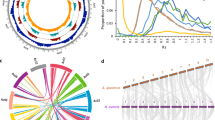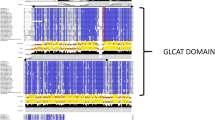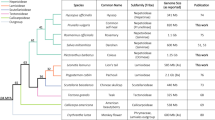Abstract
Gibberellins (GAs) are crucial phytohormones involved in many aspects of plant growth and development, including plant–microbe interactions, which has led to GA production by plant-associated fungi and bacteria as well. While the GA biosynthetic pathways in plants and fungi have been elucidated and found to have arisen independently through convergent evolution, little has been uncovered about GA biosynthesis in bacteria. Some nitrogen-fixing, symbiotic, legume-associated rhizobia, including Bradyrhizobium japonicum—the symbiont of soybean—and Sinorhizobium fredii—a broad-host-nodulating species—contain a putative GA biosynthetic operon, or gene cluster. Through functional characterization of five unknown genes, we demonstrate that this operon encodes the enzymes necessary to produce GA9, thereby elucidating bacterial GA biosynthesis. The distinct nature of these enzymes indicates that bacteria have independently evolved a third biosynthetic pathway for GA production. Furthermore, our results also reveal a central biochemical logic that is followed in all three convergently evolved GA biosynthetic pathways.
This is a preview of subscription content, access via your institution
Access options
Subscribe to this journal
Receive 12 print issues and online access
$259.00 per year
only $21.58 per issue
Buy this article
- Purchase on Springer Link
- Instant access to full article PDF
Prices may be subject to local taxes which are calculated during checkout





Similar content being viewed by others
References
Hedden, P. & Sponsel, V. A century of gibberellin research. J. Plant Growth Regul. 34, 740–760 (2015).
Hedden, P. & Thomas, S.G. Gibberellin biosynthesis and its regulation. Biochem. J. 444, 11–25 (2012).
Bari, R. & Jones, J.D.G. Role of plant hormones in plant defence responses. Plant Mol. Biol. 69, 473–488 (2009).
Hayashi, S., Gresshoff, P.M. & Ferguson, B.J. Mechanistic action of gibberellins in legume nodulation. J. Integr. Plant Biol. 56, 971–978 (2014).
Peng, J. et al. 'Green revolution' genes encode mutant gibberellin response modulators. Nature 400, 256–261 (1999).
Sasaki, A. et al. Green revolution: a mutant gibberellin-synthesis gene in rice. Nature 416, 701–702 (2002).
Bömke, C. & Tudzynski, B. Diversity, regulation, and evolution of the gibberellin biosynthetic pathway in fungi compared to plants and bacteria. Phytochemistry 70, 1876–1893 (2009).
MacMillan, J. Occurrence of gibberellins in vascular plants, fungi, and bacteria. J. Plant Growth Regul. 20, 387–442 (2001).
Tudzynski, B. Gibberellin biosynthesis in fungi: genes, enzymes, evolution, and impact on biotechnology. Appl. Microbiol. Biotechnol. 66, 597–611 (2005).
Morrone, D. et al. Gibberellin biosynthesis in bacteria: separate ent-copalyl diphosphate and ent-kaurene synthases in Bradyrhizobium japonicum. FEBS Lett. 583, 475–480 (2009).
Magome, H. et al. CYP714B1 and CYP714B2 encode gibberellin 13-oxidases that reduce gibberellin activity in rice. Proc. Natl. Acad. Sci. USA 110, 1947–1952 (2013).
Bhattacharya, A. et al. Characterization of the fungal gibberellin desaturase as a 2-oxoglutarate-dependent dioxygenase and its utilization for enhancing plant growth. Plant Physiol. 160, 837–845 (2012).
Peters, R.J. in Isoprenoid Synthesis in Plants and Microorganisms: New Concepts and Experimental Approaches (eds. Bach, T.J. & Rohmer, M.) 233–249 (Springer, 2013).
Atzorn, R., Crozier, A., Wheeler, C.T. & Sandberg, G. Production of gibberellins and indole-3-acetic acid by Rhizobium phaseoli in relation to nodulation of Phaseolus vulgaris roots. Planta 175, 532–538 (1988).
Delamuta, J.R.M. et al. Polyphasic evidence supporting the reclassification of Bradyrhizobium japonicum group Ia strains as Bradyrhizobium diazoefficiens sp. nov. Int. J. Syst. Evol. Microbiol. 63, 3342–3351 (2013).
Tully, R.E. & Keister, D.L. Cloning and mutagenesis of a cytochrome P-450 locus from Bradyrhizobium japonicum that is expressed anaerobically and symbiotically. Appl. Environ. Microbiol. 59, 4136–4142 (1993).
Tully, R.E., van Berkum, P., Lovins, K.W. & Keister, D.L. Identification and sequencing of a cytochrome P450 gene cluster from Bradyrhizobium japonicum. Biochim. Biophys. Acta 1398, 243–255 (1998).
Keister, D.L., Tully, R.E. & Van Berkum, P. A cytochrome P450 gene cluster in the Rhizobiaceae. J. Gen. Appl. Microbiol. 45, 301–303 (1999).
Méndez, C. et al. Gibberellin oxidase activities in Bradyrhizobium japonicum bacteroids. Phytochemistry 98, 101–109 (2014).
Hershey, D.M., Lu, X., Zi, J. & Peters, R.J. Functional conservation of the capacity for ent-kaurene biosynthesis and an associated operon in certain rhizobia. J. Bacteriol. 196, 100–106 (2014).
Galibert, F. et al. The composite genome of the legume symbiont Sinorhizobium meliloti. Science 293, 668–672 (2001).
Hannemann, F., Bichet, A., Ewen, K.M. & Bernhardt, R. Cytochrome P450 systems–biological variations of electron transport chains. Biochim. Biophys. Acta 1770, 330–344 (2007).
Schäfer, A. et al. Small mobilizable multi-purpose cloning vectors derived from the Escherichia coli plasmids pK18 and pK19: selection of defined deletions in the chromosome of Corynebacterium glutamicum. Gene 145, 69–73 (1994).
Sukdeo, N. & Charles, T.C. Application of crossover-PCR-mediated deletion-insertion mutagenesis to analysis of the bdhA-xdhA2-xdhB2 mixed-function operon of Sinorhizobium meliloti. Arch. Microbiol. 179, 301–304 (2003).
Mander, L.N. The chemistry of gibberellins: an overview. Chem. Rev. 92, 573–612 (1992).
Silva, L.F. Construction of cyclopentyl units by ring contraction reactions. Tetrahedron 58, 9137–9161 (2002).
Citron, C.A., Brock, N.L., Tudzynski, B. & Dickschat, J.S. Labelling studies on the biosynthesis of terpenes in Fusarium fujikuroi. Chem. Commun. (Camb.) 50, 5224–5226 (2014).
Helliwell, C.A., Chandler, P.M., Poole, A., Dennis, E.S. & Peacock, W.J. The CYP88A cytochrome P450, ent-kaurenoic acid oxidase, catalyzes three steps of the gibberellin biosynthesis pathway. Proc. Natl. Acad. Sci. USA 98, 2065–2070 (2001).
Rojas, M.C., Hedden, P., Gaskin, P. & Tudzynski, B. The P450-1 gene of Gibberella fujikuroi encodes a multifunctional enzyme in gibberellin biosynthesis. Proc. Natl. Acad. Sci. USA 98, 5838–5843 (2001).
Bertea, C.M. et al. Identification of intermediates and enzymes involved in the early steps of artemisinin biosynthesis in Artemisia annua. Planta Med. 71, 40–47 (2005).
Teoh, K.H., Polichuk, D.R., Reed, D.W. & Covello, P.S. Molecular cloning of an aldehyde dehydrogenase implicated in artemisinin biosynthesis in Artemisia annua. Botany 87, 635–642 (2009).
Du, L. et al. Characterization of a unique pathway for 4-cresol catabolism initiated by phosphorylation in Corynebacterium glutamicum. J. Biol. Chem. 291, 6583–6594 (2016).
Cao, R. et al. Diterpene cyclases and the nature of the isoprene fold. Proteins 78, 2417–2432 (2010).
Liu, W. et al. Structure, function and inhibition of ent-kaurene synthase from Bradyrhizobium japonicum. Sci. Rep. 4, 6214 (2014).
Nelson, D.R. Cytochrome P450 and the individuality of species. Arch. Biochem. Biophys. 369, 1–10 (1999).
Lange, T. Cloning gibberellin dioxygenase genes from pumpkin endosperm by heterologous expression of enzyme activities in Escherichia coli. Proc. Natl. Acad. Sci. USA 94, 6553–6558 (1997).
Jensen, N.B. et al. Convergent evolution in biosynthesis of cyanogenic defence compounds in plants and insects. Nat. Commun. 2, 273 (2011).
Ortiz de Montellano, P.R. & Nelson, S.D. Rearrangement reactions catalyzed by cytochrome P450s. Arch. Biochem. Biophys. 507, 95–110 (2011).
Song, Z.L., Fan, C.A. & Tu, Y.Q. Semipinacol rearrangement in natural product synthesis. Chem. Rev. 111, 7523–7556 (2011).
Hayashi, K. et al. Endogenous diterpenes derived from ent-kaurene, a common gibberellin precursor, regulate protonema differentiation of the moss Physcomitrella patens. Plant Physiol. 153, 1085–1097 (2010).
Navarro, L. et al. DELLAs control plant immune responses by modulating the balance of jasmonic acid and salicylic acid signaling. Curr. Biol. 18, 650–655 (2008).
Yang, D.L. et al. Altered disease development in the eui mutants and Eui overexpressors indicates that gibberellins negatively regulate rice basal disease resistance. Mol. Plant 1, 528–537 (2008).
Wiemann, P. et al. Deciphering the cryptic genome: genome-wide analyses of the rice pathogen Fusarium fujikuroi reveal complex regulation of secondary metabolism and novel metabolites. PLoS Pathog. 9, e1003475 (2013).
Lu, X., Hershey, D.M., Wang, L., Bogdanove, A.J. & Peters, R.J. An ent-kaurene-derived diterpenoid virulence factor from Xanthomonas oryzae pv. oryzicola. New Phytol. 206, 295–302 (2015).
Anderson, J.P. et al. Plants versus pathogens: an evolutionary arms race. Funct. Plant Biol. 37, 499–512 (2010).
Buikema, W.J. et al. Physical and genetic characterization of Rhizobium meliloti symbiotic mutants. J. Mol. Appl. Genet. 2, 249–260 (1983).
Trinick, M.J. Relationships amongst the fast-growing rhizobia of Lablab purpureus, Leucaena leucocephala, Mimosa spp., Acacia farnesiana and Sesbania grandiflora and their affinities with other rhizobial groups. J. Appl. Bacteriol. 49, 39–53 (1980).
Bellamine, A., Mangla, A.T., Nes, W.D. & Waterman, M.R. Characterization and catalytic properties of the sterol 14α-demethylase from Mycobacterium tuberculosis. Proc. Natl. Acad. Sci. USA 96, 8937–8942 (1999).
You, Z., Omura, S., Ikeda, H. & Cane, D.E. Pentalenolactone biosynthesis: molecular cloning and assignment of biochemical function to PtlF, a short-chain dehydrogenase from Streptomyces avermitilis, and identification of a new biosynthetic intermediate. Arch. Biochem. Biophys. 459, 233–240 (2007).
Jones, K.M. Increased production of the exopolysaccharide succinoglycan enhances Sinorhizobium meliloti 1021 symbiosis with the host plant Medicago truncatula. J. Bacteriol. 194, 4322–4331 (2012).
Backman, K. & Boyer, H.W. Tetracycline resistance determined by pBR322 is mediated by one polypeptide. Gene 26, 197–203 (1983).
Finan, T.M., Kunkel, B., De Vos, G.F. & Signer, E.R. Second symbiotic megaplasmid in Rhizobium meliloti carrying exopolysaccharide and thiamine synthesis genes. J. Bacteriol. 167, 66–72 (1986).
Morrone, D. et al. Increasing diterpene yield with a modular metabolic engineering system in E. coli: comparison of MEV and MEP isoprenoid precursor pathway engineering. Appl. Microbiol. Biotechnol. 85, 1893–1906 (2010).
Ward, J.L. et al. Stereochemistry of the oxidation of gibberellin 20-alcohols, GA15 and GA44, to 20-aldehydes by gibberellin 20-oxidases. Chem. Commun. (Camb.) 13–14 (1997).
Kamiya, Y. & Graebe, J.E. The biosynthesis of all major pea gibberellins in a cell-free system from Pisum sativum. Phytochemistry 22, 681–689 (1983).
Furuya, T., Arai, Y. & Kino, K. Biotechnological production of caffeic acid by bacterial cytochrome P450 CYP199A2. Appl. Environ. Microbiol. 78, 6087–6094 (2012).
Binks, R., MacMillan, J. & Pryce, R.J. Combined gas chromatography-mass spectrometry of the methyl esters of gibberellins A1 to A24 and their trimethylsilyl ethers. Phytochemistry 8, 271–284 (1969).
Graebe, J.E., Hedden, P., Gaskin, P. & MacMillan, J. Biosynthesis of gibberellins A12, A15, A24, A36, and A37 by a cell-free system from Cucurbita maxima. Phytochemistry 13, 1433–1440 (1974).
Urrutia, O., Hedden, P. & Rojas, M.C. Monooxygenases involved in GA12 and GA14 synthesis in Gibberella fujikuroi. Phytochemistry 56, 505–511 (2001).
Troncoso, C., Cárcamo, J., Hedden, P., Tudzynski, B. & Rojas, M.C. Influence of electron transport proteins on the reactions catalyzed by Fusarium fujikuroi gibberellin monooxygenases. Phytochemistry 69, 672–683 (2008).
Acknowledgements
This work was supported by grants from the NIH (GM109773 to R.J.P.) and the Iowa Soybean Association (grant to R.J.P.); a Discovery Grant and an Engage Grant, both from Natural Sciences and Research Engineering Council of Canada (NSERC; grants to T.C.C.); an Ontario Graduate Scholarship (A.M.); the 20:20 Wheat Integrated Strategic Programme at Rothamsted Research, funded by the Biotechnology and Biological Sciences Research Council of the United Kingdom (support to P.H.); and the Fondo Nacional de Desarrollo Cientifico y Tecnologico (grant 1150797 to M.C.R.). Authentic ent-7α-hydroxykaurenoic acid (5), GA15 (8), and GA24 (9)-methyl ester were provided by P. Hedden. ent-[17-14C1]Kaurenoic acid, [17-14C1]GA12, [17-14C1]GA15, [17-14C1]GA24, and [17-14C1]GA9 were obtained from L. Mander (Australian National University, Canberra, Australia).
Author information
Authors and Affiliations
Contributions
R.S.N. performed the heterologous expression assays, created many of the knockout bacterial strains, and wrote the manuscript. X.L. aided in cloning related to the heterologous expression assays and R.N. provided insightful data analysis. M.M. and M.C.R. performed the bacteroid incubation assays and HPLC analysis, and helped write the manuscript. A.M. and T.C.C. created several of the knockout bacterial strains. P.H. analyzed extracts from the bacteroid incubation assays by GC–MS and helped write the manuscript. R.J.P. conceived the project, aided in data analysis, and helped write the manuscript.
Corresponding author
Ethics declarations
Competing interests
The authors declare no competing financial interests.
Supplementary information
Supplementary Text and Figures
Supplementary Results, Supplementary Figures 1–12 and Supplementary Tables 1–9. (PDF 2404 kb)
Rights and permissions
About this article
Cite this article
Nett, R., Montanares, M., Marcassa, A. et al. Elucidation of gibberellin biosynthesis in bacteria reveals convergent evolution. Nat Chem Biol 13, 69–74 (2017). https://doi.org/10.1038/nchembio.2232
Received:
Accepted:
Published:
Issue Date:
DOI: https://doi.org/10.1038/nchembio.2232
This article is cited by
-
Engineered and total biosynthesis of fungal specialized metabolites
Nature Reviews Chemistry (2024)
-
Developmental Phytohormones: Key Players in Host-Microbe Interactions
Journal of Plant Growth Regulation (2023)
-
Production of the plant hormone gibberellin by rhizobia increases host legume nodule size
The ISME Journal (2022)
-
Structure-guided product determination of the bacterial type II diterpene synthase Tpn2
Communications Chemistry (2022)
-
Wheat dwarfing influences selection of the rhizosphere microbiome
Scientific Reports (2020)




